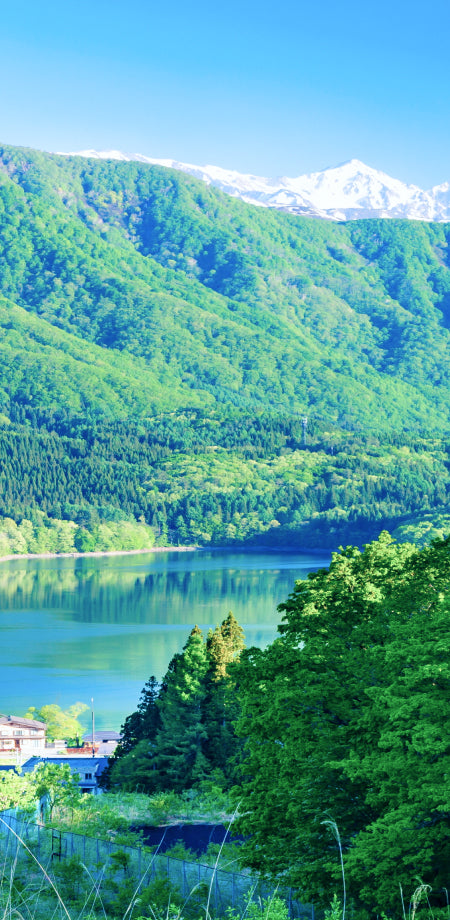投稿日:
更新日:
A truly exquisite taste aged in the snow to a heavy snowy area
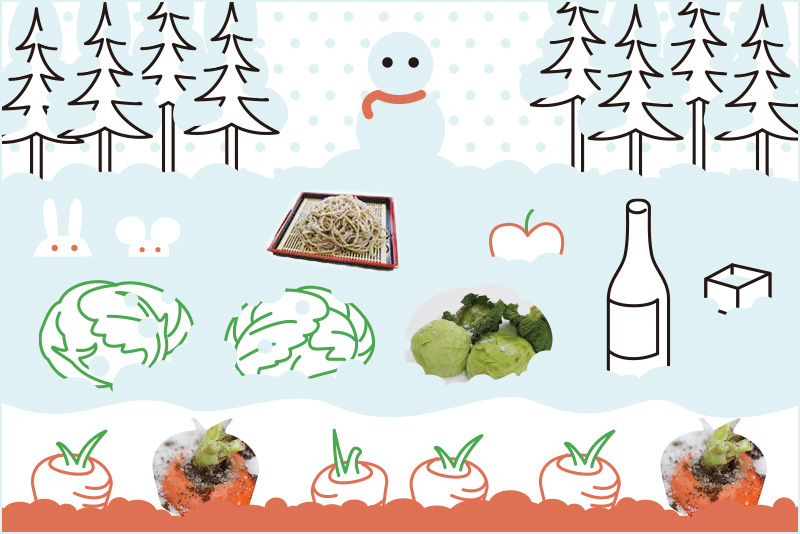
A limited-time brand vegetable grown by snow - delicious cores in the snow from Otani Village
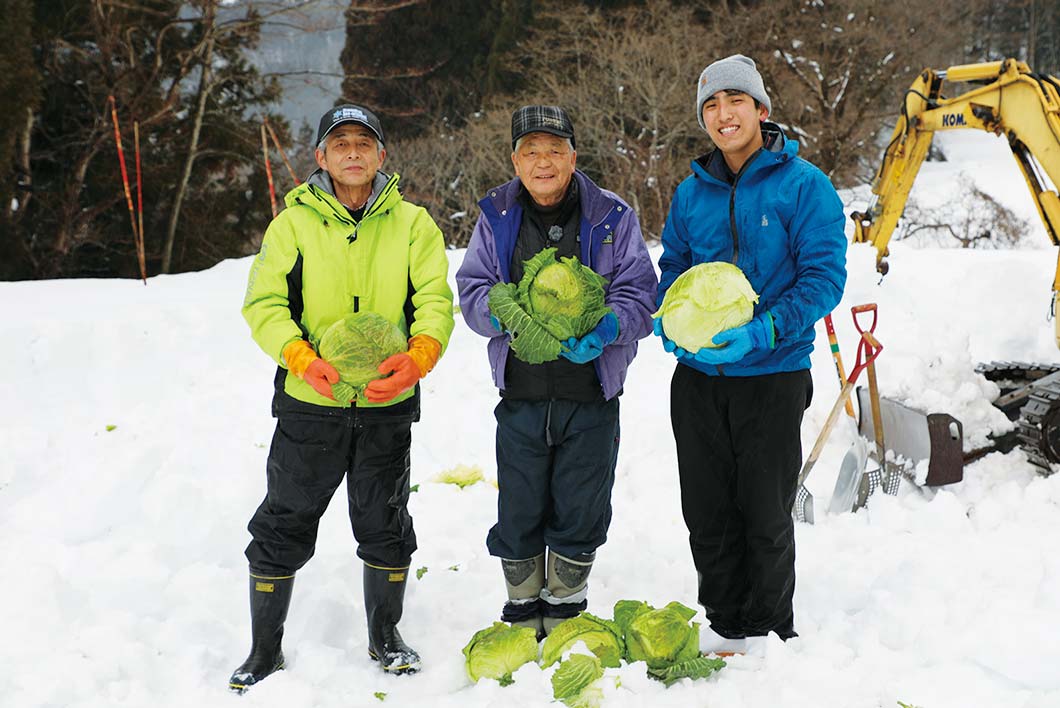
Sakai Akiju (center) from the Iori Agricultural Production Association, consisting of residents of the Iori village, and Aoki Tsuyoshi (right) from JA Daikita. The Iori village grows between 2,000 and 3,000 plants.
Iori Agricultural Production Association
Sakai Shoju
JA Daikita
Aoki Tsuyoshi
Nagano Otani Village is located in the northwest of the prefecture at the foot of the Northern Alps, and is embraced by mountains with an altitude of 1,600 to 2,800m. It is so deep that it is designated as a "special heavy snow area," and will be closed to snow until early April. The extremely sweet "cultured under the snow for at least two weeks after snowfall is extremely sweet" in the fields within Otani Village.Shinshu"Steal cabbage in the snow."
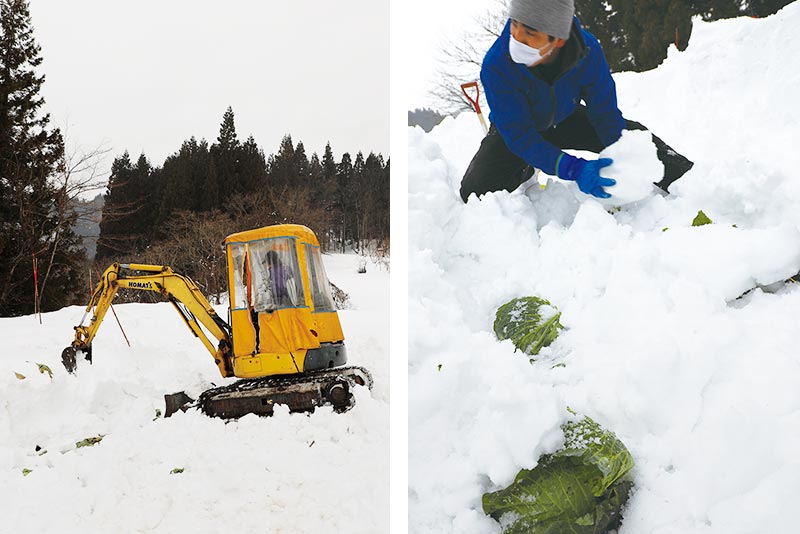
Snow about 2m deep is digged with heavy machinery or shovels, and finally, carefully harvested by hand.Shinshu"Senior cabbage in the snow." In addition to members of the production association, many people come from outside the village and outside the prefecture to help out, harvesting work, which is mainly carried out on Saturdays and Sundays, making it an opportunity for people to interact with each other.
Snow began to fall in the village around December, and the cabbage was covered in moist snow, which contained a lot of water from the Sea of Japan, and the harvest began in January. The harvest is done with heavy machinery, then with a shovel to dig the snow through the cabbage, and finally with a careful hand to remove the snow. A typical cabbage weighs around 1.3kg per ball, but cabbage in the snow is average, around 2kg, and a larger one can sometimes harvest a whopping 6kg class.
What's more, its most appeal is its sweetness. Normally, cabbage has a sugar content of 3-4 degrees, andShinshu"Yutari Cabbage in the Snow" boasts a sugar content that is comparable to strawberries, at a temperature of over 8 degrees. The temperature is almost 0 degrees under the snow, and the cabbage remains at an exquisite temperature that does not freeze, and as the cabbage is hard to store sugar to prevent it from freezing, the sweetness increases dramatically in a short period of time, while reducing the spiciness and bitterness. The flavor that is brought out from the vitality of cabbage and the freshness that is unique to cultivating in the snow stands apart from "snow storage," which stores vegetables and other vegetables in the snow.
The village has been eating cabbage in the snow mainly for its own use since the early Showa era, and around 1958, it began producing cabbage in the snow, thinking that it could be used as a source of income in the winter. However, all snow removal work at the time was done by hand, and it was even more laborious than ever before, and the distribution network had not developed, so although there were records of the shipment being made to the Hokuriku region, he gave up after a few years. However, as the 2000s began to become more active in agriculture on a village-wide basis, a turning point came. Sweet and delicious snow cabbage has gained attention as a rare item, and has once again been cultivated for shipping. It is currently produced in 11 village villages, and in 2016 they collaborated to meet production issues and aimed at establishing a brand.ShinshuEstablished the "Otari Snow Cabbage Production Association". Three village farming organizations, one corporation, and nine individuals cooperate with the village and JA, and also hold cultivation guidance and reflection meetings before and after planting.
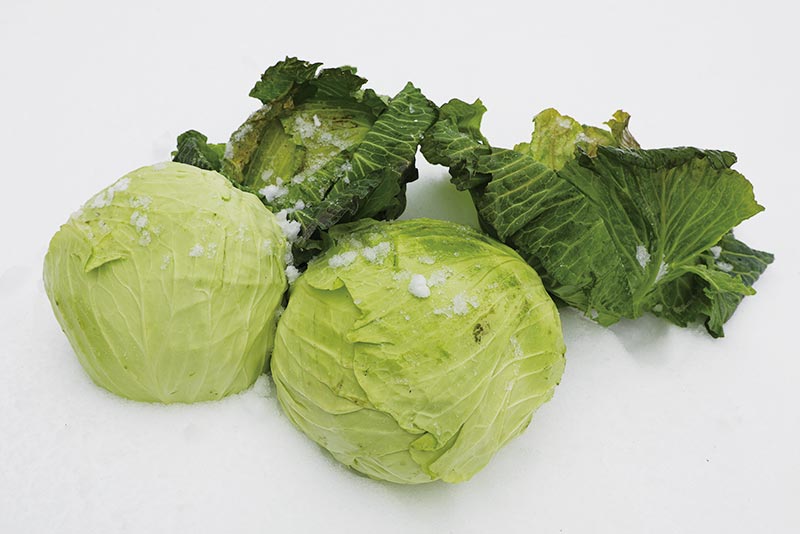
The harvest is at the end of February. In March, cabbage sprouts to try to bloom, causing its sugar content to decrease. This is a limited time item.
In 2020, 20,000 cabbage seedlings grown in the village were planted. It is said that the harvest is usually about 70% due to insect damage in the summer, food damage caused by mice, and scratches from digging. Regarding the growing situation this year, Sakai Akiju from Iori Village, one of the producers, expressed his confidence, saying, "The weather was blessed with good condition, and cabbage was produced in good condition. In years when there is little snow, it freezes (and becomes amber color), but this year's version is green, has a good taste, and the balls are big."
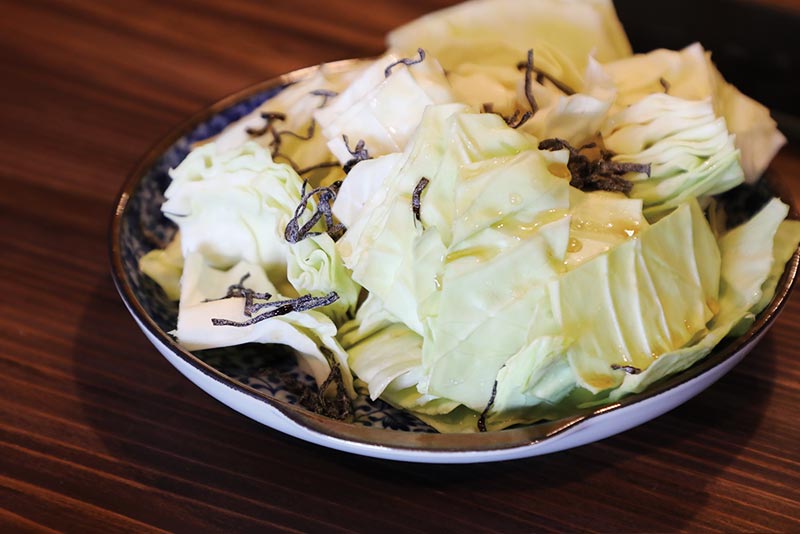
Snow cabbage, simply seasoned with sesame oil and salted kelp, is perfect for tea-making. The closer you get to the core, the sweeter it is, and there is no cabbage smell.
When asked about how to eat it, he said, "First, eat it raw!" I bite into the freshly harvested and it filled my mouth with a crisp texture and amazing sweetness. The core of cabbage in the snow has the sweetest core, so it is also recommended to cut the core and make tempura. It seems that the sweetness is even more noticeable.
"Cabbage in the snow has become a branded vegetable. In the future, we would like to ensure stable production even if the weather is slightly bad and further establish a sales route," says Aoki Goji of JA Daikita. As one of the "Northern Alps Foothills Brands" and as a product of a snowy country, cabbage in the snow will continue to develop.
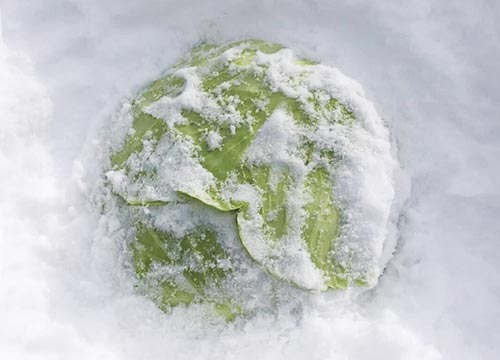
Where can I buy cabbage in the snow?
「Shinshu"Otari Snow Cabbage" has been selected as a gift for the hometown tax donation of Otari Village, and is also known as "Road Station Kotani" Nagano It can also be purchased at supermarkets in the prefecture and at the internet. The cabbage in the snow from the Iori village of Otani Village that I visited this time can be ordered from the fax or through the Iori no Sato Yukiwariso website, and in addition to one bean (1,800 yen), two beans (3,300 yen), one bean with snow (2,500 yen). Please try the unique taste of Otani Village in winter. *Shipping charges apply to all items.
Iori no Sato Yukiwariso homepage
http://yukiwarisou-iori.com/
[ShinshuOtari Snow Cabbage Production Association (inside the Agriculture and Forestry Section, Tourism Promotion Division, Otari Village Office)]
Nakanotani Bike 131, Otani Village, Kitaazumi District TEL 0261-82-2588
It's like fruit! Sweet snow carrots grown in snowy regions
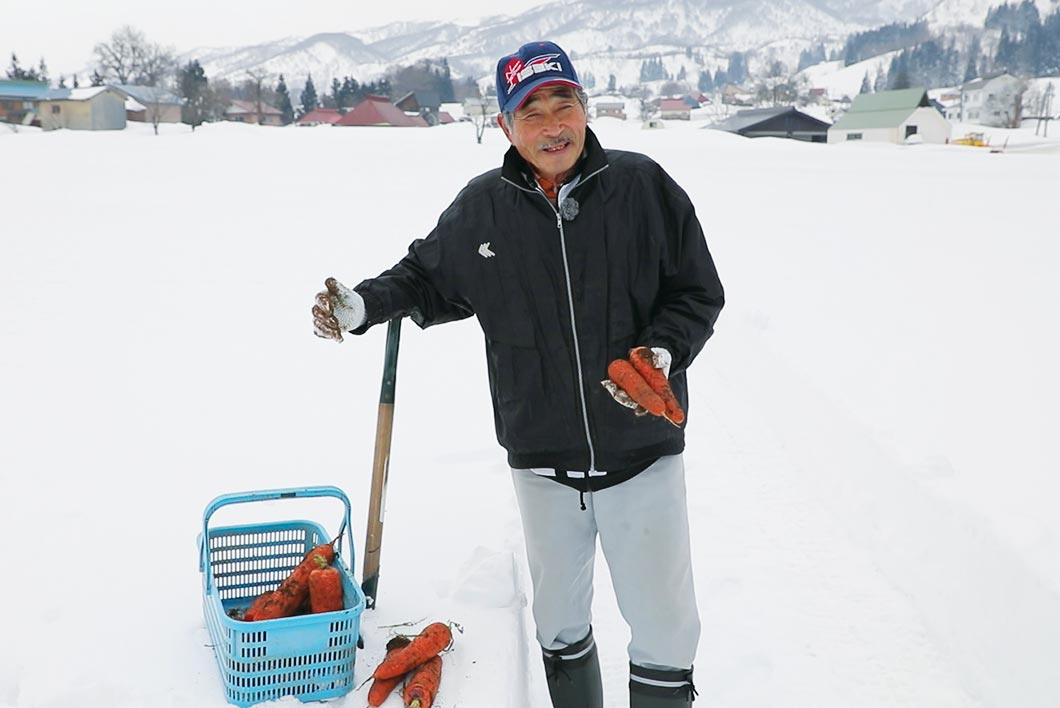
"Customer feedback has been the driving force behind cultivation by saying, "Let's do our best this year too," Eguchi said.
Farm Nabekura
Eguchi Muneharu
Nagano Located on the border between the prefecture and Niigata prefectureIiyama City"Nabekura Plateau" is in the "Nabekura Plateau." It is known as one of the heaviest snow areas in the prefecture, with 6m of snow piling up in many years.
"In the past, agriculture scholars were working on revitalizing local areas.ShinshuWhile drinking with the late professor Emeritus Tamai Kesao at the university, I talked about how "it's snowy in this area, so we can't do anything in the winter, but when the snow melted, I happened to eat carrots that were still in the fields, and it was delicious," and the professor suggested, "I should definitely make it into a commercial product."" says Eguchi Muneharu, who has grown snow in this area for about 40 years.
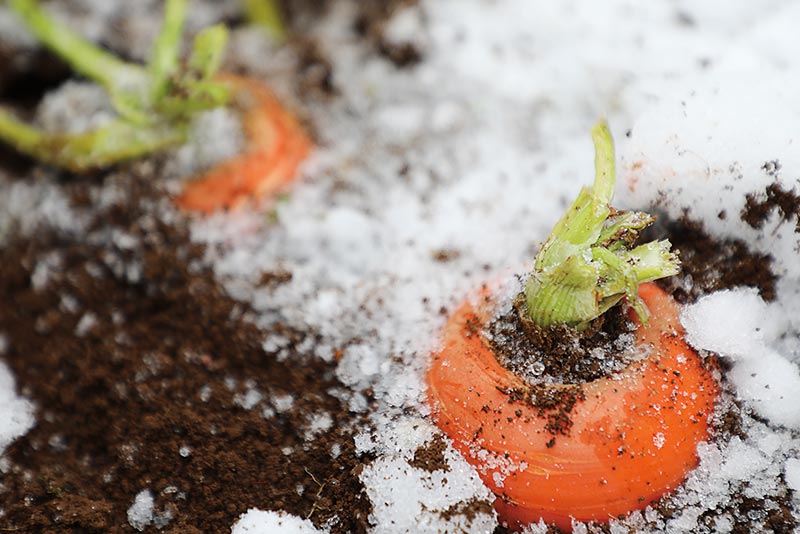
The temperature is maintained at an exquisite 0°C under the snow, and the carrots in the soil condense the sweetness without freezing.
From sowing seeds in July to harvest at the end of April, it takes 9-10 months, more than twice the usual amount.Timesをかけて栽培され、約半分の期間は雪の下で甘みを凝縮するスノーキャロット。 Due to food damage caused by animals such as mice or root rot from the snow melt, the yield can be about 70% compared to regular carrots. As a result, the taste is exceptional, and once you take a bite, the crisp texture and sweetness fill your mouth. It has little carrot smell, making it seem like eating fruit. They often receive letters of joy from buyers, such as "No vegetable has been so touched by this," and "Even children who hate carrots are happy to eat snow carrots," and receive calls waiting for the harvest, and many fans become captivated by the taste once they eat it.
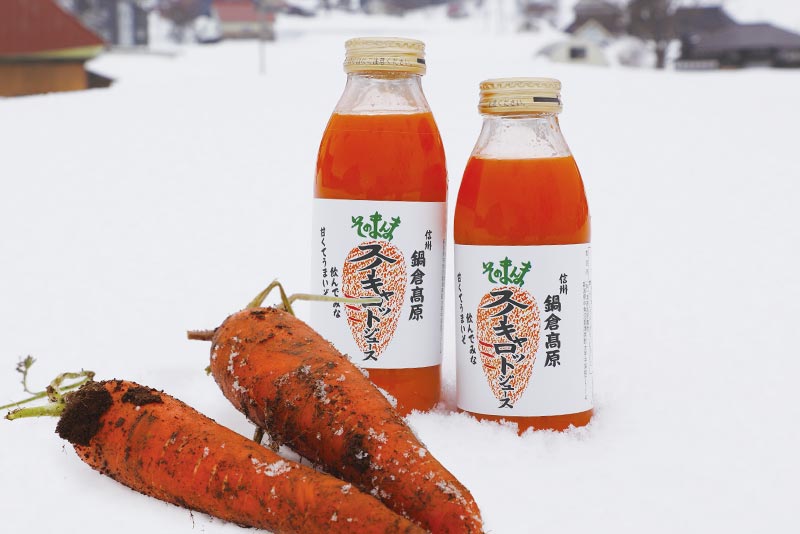
Eguchi studies a variety of varieties to make more delicious snow carrots. He is currently experimenting with varieties called "Aroma Red" and "Hitomi® Five Sun", which are characterized by their vibrant colors and sweetness.
On the other hand, when excavated from cold soil that is closed by snow, the temperature difference between the surface and the ground causes the damage to occur quickly, and the period of raw food can only be eaten from the end of April to mid-May, when the harvest period is late April. Therefore, in response to the desire to enjoy snow carrot for a longer period of time, it was born.Shinshu"Nabekura Kogen is exactly like snow carrot juice." It has a sweet and rich flavor that is hard to believe it is made from carrots alone, and is also sold at nearby road stations, supermarkets in the prefecture, as well as online shopping sites.
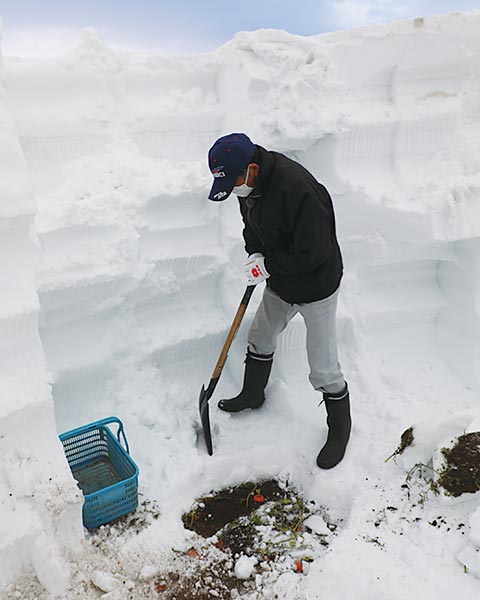
Mr. Eguchi tried out the snow over more than 2m.
Eguchi has been rooted in such deep snowy lands and has produced products that make use of the climate. Mr. Eguchi also said, "The challenge is not only to agriculture, but how to live with the snow in this area. Even if it's still quiet, it will fall, so we have to make good use of it," and he also felt a sense of his desire to take the next challenge.
[Farm Nabekura]
Iiyama CityIchiyama 1434 TEL 0269-69-2822
Create added value for the region with snow
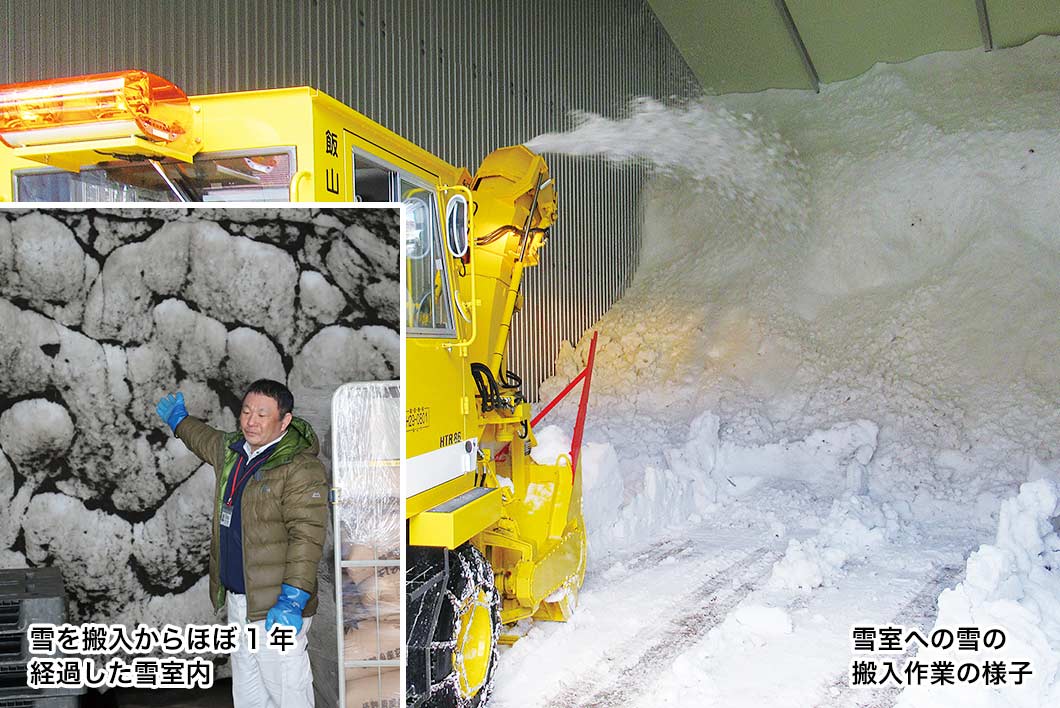
The snow that was brought into the snow room in mid-February had not melted after about a year, and about 20% remained inside.
Iiyama CityGeneral Affairs Department, Public and Private Partnership Promotion Office
Matsukawa Mikuyoshi(Muneyoshi)Mr. Miss.
Iiyama Soba Promotion Research Group, General Incorporated Association
Executive DirectorShimizu Akihiro
Since ancient times, in areas with heavy snow, wisdom has been rooted in daily life to take advantage of the coldness of snow, such as "storage in the snow" and "snow chambers" that store and utilize snow until summer. It has become obsolete with the spread of freezers and refrigerators, but the use of snow is beginning to be reconsidered.
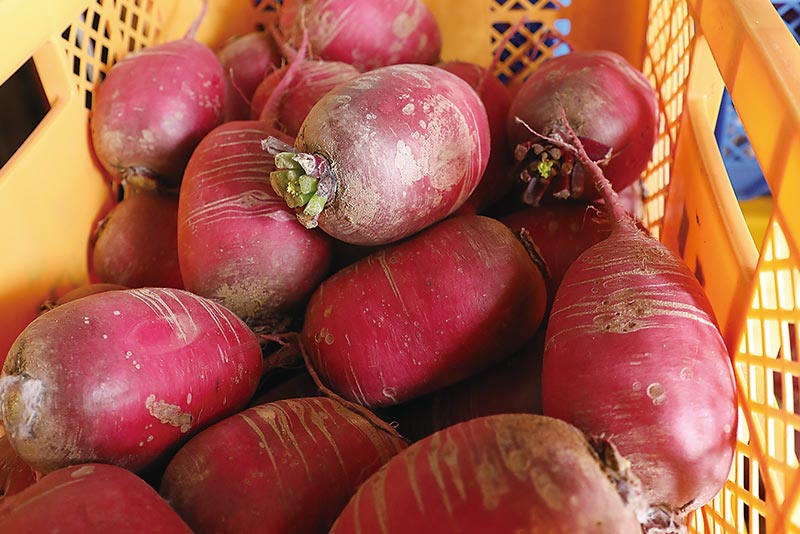
They also store beets and red core radish, which are rare in Japan, grown by farmers in the city.
Approximately 120cm in the city, and 3m in the mountainsIiyama City. Daily snow shaking is a common thing in everyday life. Three years ago, I wondered if I could use this snow as a resource and utilize it.Iiyama CityThe Public Citizens' Collaboration Promotion Office took the lead, and experiments began renovating and using unused warehouses in the city into modern versions of "Snow Room." The snow room, which covers 70 to 80% of the space inside the building, is a natural, high-performance refrigerator that maintains a temperature of 1-3 degrees and 100% humidity throughout the year. This is an attempt to preserve local sake, root vegetables, gensoba, rice, and more.
Then the results began to be good. Not only is it possible to ship differently by keeping it fresh for a long period of time by cold storage, but it also has also changed the taste, with sake becoming mellow and potatoes becoming sweeter.中でもそばは、通常であればTimesThe flavor also faded, but the gensoba, which was stored in the snow room, had a scent even in the summer, and the sweetness was slightly increased.
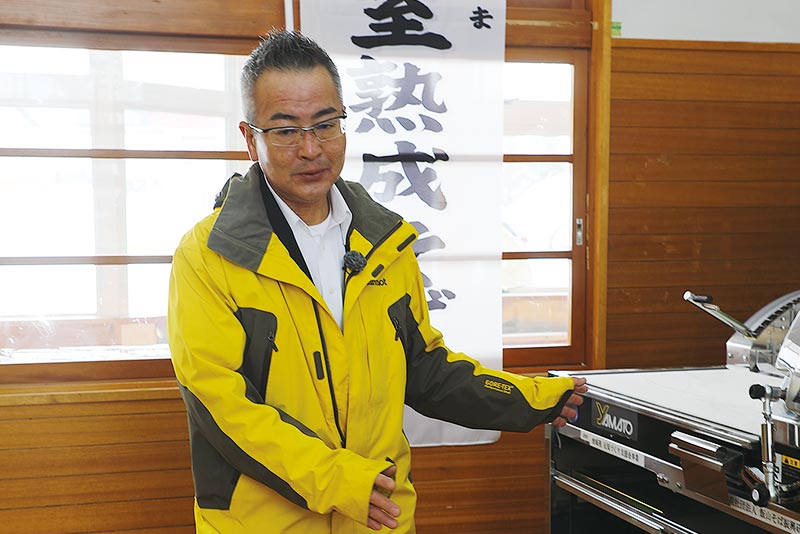
"In the future, we would like to use local flour from the wire to make local production and consumption," says Shimizu.
The Iiyama Soba Promotion Research Association, a general incorporated association, was established to commercialize this gensoba. Three years ago, they began working as a voluntary organization, and became incorporated in August last year, and in December they set up a base in the city, starting full-scale activities. "Iiyama Yukimuro Aged Soba," which uses gensoba that has been aged in snowrooms for over three months, is currently available at two restaurants in the city, and is aiming to be branded along with Tomikura soba. Shimizu Akihiro, executive director of the study group, said, "In the future, we would like to continue working to make this soba noodles more widely known."
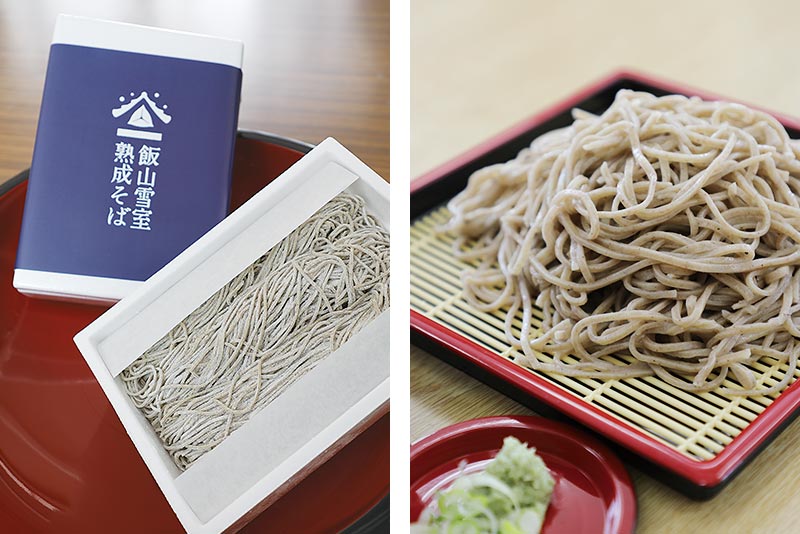
Iiyama Yukimuro Aged Soba is characterized by its aroma like new soba and a subtle sweetness. Preparations are underway for sale.
A snow room that is energy-saving, environmentally friendly, and adds value to products. This initiative won the Minister of Education, Culture, Sports, Science and Technology Award at the "Decarbonization Challenge Cup 2021," which recognizes various initiatives across the country that will help prevent global warming. Matsukawa Mikuchi, a city manager, talks about his future prospects, saying, "We often suffer from snow, but we would like to make use of the snow to be considered a 'gift from nature', and we would like to create a 'Iiyama Yukimuro Gozen' (tentative name)' using specialty products stored in the snow room, leading to a development that will make it possible for people to come to the local community and enjoy themselves."Iiyama CityWe can't take our eyes off the future developments towards "Rishiki."
[Iiyama CityGeneral Affairs Department, Public and Private Partnership Promotion Office]
Iiyama CityIiyama 1110-1 TEL 0269-67-0725(Direct connection)
https://www.city.iiyama.nagano.jp/
There are many other things
It is matured slowly with the power of snowShinshuSpecialties of
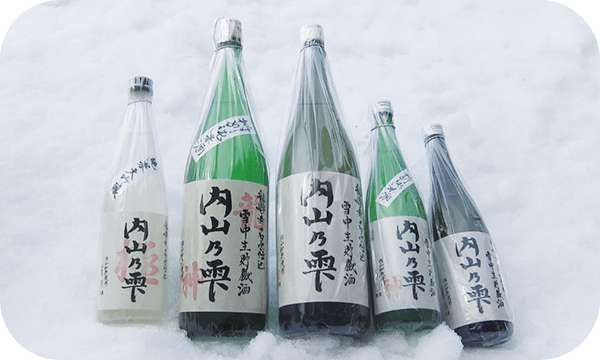
Japanese sake
It boasts the second largest number of breweries in the country, with around 80, and many breweries brewing carefully selected sake in small quantities. Nagano prefecture. There are also breweries that aged sake in the snow, and there are also movements to make it a local specialty, such as "Togakushi Snow Sake," which is buried in the snow in Togakushi Junior High School's grounds for about three months, and "Uchiyama No Shizuku" by the Uchiyama Sake Rice Research Group in Kishimahira Village. The temperature is kept constant in the snow, so it matures slowly and gives it a mellow taste.
(Photo) Uchiyama no Shizuku is aged in the snow, local sake made with local water and rice.
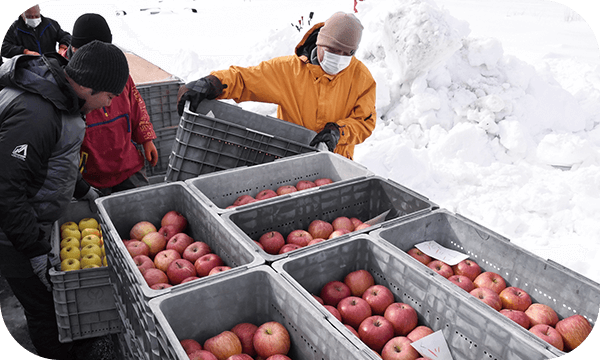
apple
Nagano CityJA Green stores apples in the snow in the Ooka area for about two months Nagano "Storage in the snow" by the company and "Snow Sleeping Apples" stored in the snow room facility in Iizuna Town. Nagano There are efforts to utilize and preserve the prefecture's representative fruits and apples. Unlike a refrigerator, the environment maintains high humidity, and you can enjoy the freshness and texture of apples even in spring.
(Photo) JA Green Nagano The snow storage work carried out in January this year by staff members.
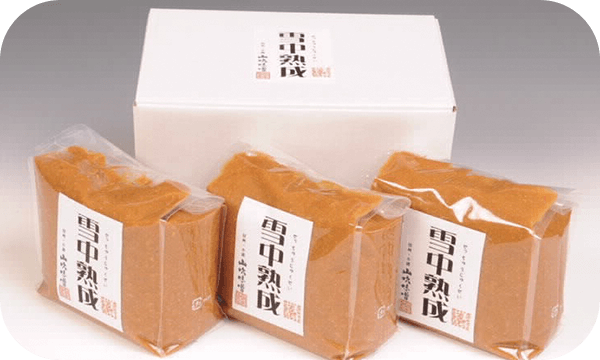
miso
Longevity of fermentation prefecture Nagano There is also an initiative to preserve miso in the snow, which is the prefecture's number one in the country. Yamabuki Miso, which has been in business for over 340 years in Komoro City, has been selling a limited quantity of "Snow-in-the-Snow Miso," which has been aged for about a year, to sleep for another three months in the snow in Takamine Plateau, Komoro City, in limited quantities since 2010. It is said to be more mellower than regular miso, and is a popular product with many repeat customers every year.
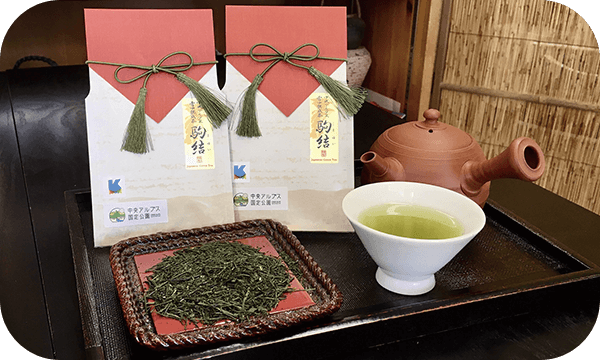
Japanese Tea
Komagane City"Snow Tea" is being carried out in the Komagane Terrace, a revitalization project in the central city area. This is a project in collaboration between the Japanese tea specialty store "Chabu Yamajien" and Chuo Alps Kanko Co., Ltd., and is a highly aromatic Southern tea made from deep steamed tea from Shimada, Shizuoka Prefecture.ShinshuIt is blended with tea from Toyama-go and stored for about three months in the snow at the Senjojiki Curl, the Central Alps, at an altitude of 2,600m. It will have a mellow and deep flavor, and is scheduled to be on sale this year around June.
This article is information as of February 2021.
Please note that the products we carry may have changed.















